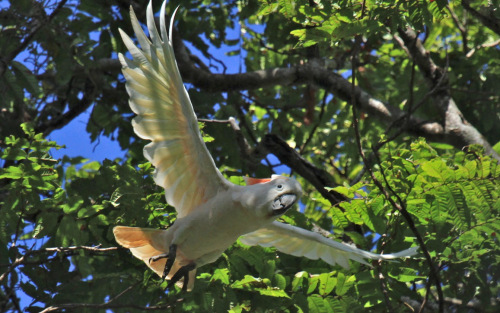BOGOR, Indonesia (15 August, 2012)_Efforts to totally ban traditional, un-intensive agricultural activity inside an Indonesian national park that is a stronghold for the endangered Moluccan cockatoo could negatively affect the very species the park was created to protect, ongoing research by CIFOR indicates.
“It appears that Moluccan cockatoos depend, to some extent, on the human modified forests such as mixed forest gardens and damar forests which are contained inside the Manusela National Park. If a complete ban on traditional agricultural practices in this park was enforced, this could actually be detrimental to the cockatoo population,” said Masatoshi Sasaoka, a CIFOR postdoctoral research fellow who has been conducting field work in an upland community in central Seram near the park since 2003.
The salmon-crusted cockatoo (Cacatua moluccensis) is endemic to the central Moluccan islands in east Indonesia. The 60,000-strong wild population can still be found on Seram Island. The puffy, salmon-crested cockatoo, a picture of which appears on the Manusela park’s logo, attracts bird watchers from across the globe.
“As we can see … this parrot is conceived as a species with high conservation value which attracts the attention of a great many people,” said Sasaoka while at the 13th Congress of the International Society of Ethnobiology, in Montpellier, in May.
Though ongoing agricultural activities inside the park have been regarded as potential threat to biodiversity and have been banned by Indonesia’s Park Management Authority, the 1,500 villagers that live in the mountain area around the park have long maintained forest gardens, rich in fruiting trees such as durian, jackfruit and water rose apple, and damar forests (Agathis damara), used for sustainable resin production for fuel.
These forest gardens are patchily distributed in mostly old secondary forests (forests which have re-grown after a major disturbance such as agriculture), and have been quite extensively managed by the villagers. Damar forests are patchily distributed in old secondary and primary forests.
The Moluccan cockatoos — listed in the most endangered category of animals on earth by the Convention on International Trade in Endangered Species (CITES) — appear to frequently use these human-modified forest patches, said Masatoshi Sasaoka, who has focused on the interrelationships between human and the cockatoo formed through indigenous arboriculture in central Seram since 2010 with his collaborators Yves Laumonier and Ken Sugimura.
Though his research is still awaiting a comparison of the relative abundance of cockatoos in each forest type, of the 78 cockatoo sites spotted by local villagers (sites recognised by the villagers as those where Moluccan cockatoos are frequently and commonly seen or heard), 67 were located in human modified forest gardens. Over a quarter of these were in the park.
“If human modified forests are important habitats for the Moluccan cockatoo, there is a possibility that the current national park management’s measure to strictly exclude any human intervention through agriculture inside the park is inappropriate to promote conservation without damaging the livelihoods of the local people who live in remote forest area,” Sasaoka said ahead of next month’s World Conservation Congress in South Korea, where leading environmental and developmental authorities will discuss ways to protect, manage and govern nature, including the establishment of protected reserves.
“It would be necessary to examine whether it is appropriate to apply conventional ‘zone-based conservation models’ that separate strictly human resource use areas and wildlife habitats on the basis of more objective quantitative data,” he added.
It is still unclear to what extent the cockatoos are dependent on the human modified forests formed through indigenous arboricultural practices.
“We conducted participatory parrot transect surveys in cooperation with local villagers during the durian and jackfruit fruiting season. We are planning to do similar surveys during the non-fruiting season for avoiding seasonal bias. On the basis of data collected by the surveys, we would like to compare the relative abundances of cockatoos between human modified forests and natural forest.”
Sasaoka and his collaborators intend to publish the complete findings in 2013.
We want you to share Forests News content, which is licensed under Creative Commons Attribution-NonCommercial-ShareAlike 4.0 International (CC BY-NC-SA 4.0). This means you are free to redistribute our material for non-commercial purposes. All we ask is that you give Forests News appropriate credit and link to the original Forests News content, indicate if changes were made, and distribute your contributions under the same Creative Commons license. You must notify Forests News if you repost, reprint or reuse our materials by contacting forestsnews@cifor-icraf.org.
